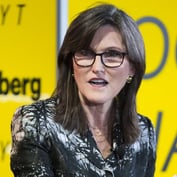What You Need to Know
- Depending on how long the war lasts, supply shocks could exacerbate already high inflation.
- Hightower's Stephanie Link expects at least four Fed rate increases this year.
- Link is reducing financials, industrials and energy, and adding health care and select tech with strong fundamentals.
As the world watches the bloodshed in Ukraine unfold with little ability to predict how and when it will end, investors are jittery and the markets remain volatile. Equity market investors are assessing the impact of the war and sanctions on the supply of energy and other commodities to gain an understanding of how it’s likely to affect companies, their supply chains and global inflation.
Depending on how long the war lasts, supply shocks could significantly exacerbate an already hot inflation picture. Europe imports about 40% of its natural gas and more than a quarter of its oil from Russia. Together, Ukraine and Russia account for almost 30% of global wheat exports. The Federal Reserve, set to announce a 25-basis-point increase at its next meeting, will need to act swiftly and decisively to ensure inflation doesn’t impede the U.S. recovery.
To put in perspective just how behind the curve the Fed is on controlling inflation, consider this: This month, the Fed is in the market buying the same amount of bonds as it did in April 2020, when the economy was in crisis. Although quantitative easing is set for completion this month, it shows that the Fed hasn’t even begun to tighten, despite high inflation and clear indicators that the economy is on track. This year, I’m expecting at least four rate increases and depending on the data, probably more.
In a sign that investors are confident about the prospect for U.S. companies, data from Bank of America shows that equity inflows year to date are $86 billion, and they were up $63 billion in February alone. The most recent purchasing managers, manufacturing and industrial production data have all come in strong. Bank of America also announced that its customers’ combined credit and debit card spending increased 21% year on year in February, while deposit balances also increased a healthy 15% year on year.
At the same time, geopolitical, inflationary concerns and the beginning of normalized monetary policies are driving contractions in S&P 500 price/earnings ratios, from 23.6x to 18.5x, according to FactSet — a sign that inflated valuations are coming down. To find alpha right now, I’m staying diversified and am focused on fundamentals, looking for companies with real earnings growth, strong margins, robust balance sheets and free cash flow.
Keeping the Recovery on Track
The latest U.S. inflation data reinforced that inflation must be reined in sooner rather than later. The consumer price index hit a four-decade high in February, increasing 7.9% year on year as gasoline, food, shelter and other costs rose. Core CPI, excluding food and energy, surged 6.4% year on year. On the wholesale side, the PPI index rose a whopping 9.7% in January for the 12-month period. Year on year, PPI Services inflation rose 7.8% and goods rose 13.1%.
The Fed’s preferred inflation indicator, the core personal consumption and expenditures (PCE) price index, is also elevated. Core PCE rose 5.2% in January from a year ago, far above the Fed’s 2% target, and the biggest rise since April 1983. At the same time, consumer spending accelerated faster than expected, rising 2.1% from December.
Along with elevated inflation, we’re seeing brisk economic activity that confirms we are firmly in reopening mode. The Institute for Supply Management’s Manufacturing Report on Business showed that economic activity in both the manufacturing and service sectors grew in February, with the overall economy achieving its 21st consecutive month of growth.









 March 15, 2022 at 02:22 PM
March 15, 2022 at 02:22 PM











